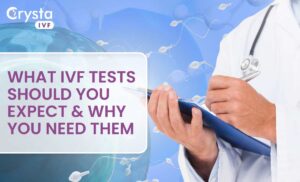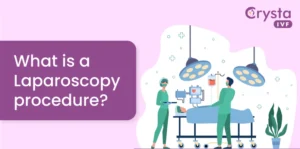We know how it feels.
There you are assuming your missed periods as the most waited ‘good news’ but then you realize you’re not pregnant. It’s heart-wrenching!
You might then impatiently stumble upon the questions like: Why can’t I get pregnant? Is IVF right for me?
When you are impatiently planning to start your family but failing to achieve a successful conception, it is the time when you try searching for the right fertility treatment to get pregnant. Many couples experience difficulty conceiving but a few of them are open about it may be due to societal issues or other reasons. One thing that should keep you motivated about your infertility or failed conceptions is that you are not alone in this journey and getting pregnant with IVF treatments is possible.
While planning to undergo fertility treatments in Hyderabad or other parts of India, you go through a lot of IVF or fertility-related websites to look out for the best possible ways or methods that are used to treat infertility-related disorders.
Google or other search engines show different results and treatments but are you aware of the fertility-related terminologies? Do you understand each medical or fertility-related term?
Well, if this is your first time for fertility treatment, then there are possible chances that run into a lot of IVF terms that you are unfamiliar with. You’ll probably need to run a deep search about what IVF is in medical terms.
Fret not. In our pregnancy glossary, we will explain all the IVF medical abbreviations and pregnancy-related terms that will help you in your IVF journey.
Let’s explore!
A
Adhesions
It is a scar tissue that forms due to the infections, inflammation or a surgical procedure, etc.
Aneuploid embryo
An aneuploid embryo has more or fewer than the standard 46 chromosomes.
Aspiration
Aspiration is a surgical procedure in IVF where sperm or eggs are obtained for examination.
Assisted Hatching
Assisted Hatching is a laboratory procedure wherein a small hole is made in the zona pellucida (gel-like covering of embryo) to allow a successful implantation of the developing embryo in the uterine wall.
Assisted Reproductive Technology (ART)
Assisted Reproductive Technology procedure is an umbrella term of different fertility treatments like In Vitro Fertilization (IVF), Intrauterine Insemination (IUI), Intracytoplasmic Sperm Injection (ICSI), Zygote Intrafallopian Transfer (ZIFT), Gamete Intrafallopian Transfer (GIFT) and Tubal Embryo Transfer (TET).
Azoospermia
Azoospermia (no sperm count) is a fertility condition wherein a male has a complete absence of sperm in the semen.
Amenorrhea
A woman who experiences the absence of monthly periods.
Andrology
Andrology is the medical study of male reproductive and urological disorders that help in examining the infertility problems in men.
B
Blastocyst
The term ‘blastocyst’ means the stage or form of human embryo 5 – 6 days after egg fertilization. It is the phase of embryo development that the embryo must reach before it gets implanted in the uterus.
Blastocyst Transfer
A blastocyst transfer is an embryo transfer which includes transferring one or more embryos that are at an initial stage of development. This is usually performed on the fifth day after the follicular aspiration.
Biochemical Pregnancy
A biochemical pregnancy is known as the early stage of miscarriage or abortion that takes place during the initial stage of pregnancy.
Basal Body Temperature
The basal body temperature technique is a method used in family planning. It the non-pathologic temperature of the body that is measured after a certain amount of rest.
BETA hCG TEST (BhCG)
Beta human chorionic gonadotropin (HCG) test performed to confirm or diagnose the pregnancy. HCG is a hormone that placenta produces during pregnancy.
Bromocriptine
Bromocriptine is an oral drug used to decrease the prolactin levels.
Blighted Ovum (Egg)
Blighted Ovum is a terminology used to illustrate the condition of the failure of an intrauterine pregnancy for the development of a fetus with heartbeat. It can also be termed as an Empty Sac pregnancy.
C
Cycle
A full cycle of IVF treatment comprises ovarian stimulation and egg recovery, insemination, and embryo replacement that take around 7 to 8 weeks.
Clinical Pregnancy
A pregnancy that experts verify not only by a blood test, but also by ultrasound examination of a gestational sac in the first trimester of pregnancy.
Complete Blood Test (CBC)
A usual preoperative blood test that provides information related to infection and anemia.
Coitus
A sexual intercourse
Cervical Mucus
Cervical Mucus is fluid produced by the cervix which varies in thickness according to the stage of the menstrual cycle. It changes in texture, color and consistency.
Cryopreservation
It is a procedure that involves the storing and cooling of tissues, cells or organs at low temperatures to enhance their viability. In this process, organelles or cells are preserved by freezing.
Colposcopy
Examining the cervix for the presence of abnormal cells with the help of a scope.
D
Danazol
A drug used as a fertility drug for the treatment of endometriosis. It suppresses the cyclic production of FSH/LH to reduce the hormonal stimulus required by the disease.
Donor Embryo
Couples who cannot conceive on their own are often offer donated embryo for a successful conception and a healthy pregnancy.
D & C – Dilation and Curettage
It is an invasive procedure, wherein the cervix is dilated so that the cervical canal and endometrial lining can be scraped with spoon-shaped equipment known as a curette.
Dyspareunia – Painful intercourse
E
Embryo
The developing offspring in the initial phases of fetal growth, from conception to the eighth week of pregnancy. In infertility treatments the term means a fertilized egg, ranging from 1 to 5 days old, used in IVF treatments.
Ectopic Pregnancy
A condition where an embryo implants and grows outside the uterus, usually in a fallopian tube.
Endometriosis
Endometriosis is a condition in which tissue similar to the tissue that forming the uterus lining develops outside the uterine cavity. The inner lining of your uterus is known as the endometrium.
Estrogen
The primary steroid hormone that ovaries produce from puberty to menopause.
Endometrial Receptivity Analysis (ERA)
Endometrial Receptivity Analysis is a test that is performed to ascertain the receptivity of the endometrium. ERA may boost the chance of pregnancy by predicting the superlative time for the implantation of the embryo during an IVF cycle. A biopsy of endometrial tissue is extracted and examined.
Estradiol
Estradiol is one of three estrogen hormones you’re your body produces naturally. While men and women both have hormone estradiol, women have superior levels of the hormone than men.
F
Fertilization
Fertilization is considered as the process of penetration of an egg by a sperm and the combination of genetic material.
Fetus
The growing baby after the embryo phase, from the ninth week of pregnancy until a successful baby birth.
Follicle
Ovarian follicles consist of egg cells that are released at the time of ovulation. These are the small sacs that comprise of fluid that one can find inside a woman’s ovaries.
Frozen Embryo Transfer (FET)
The utilization of a frozen embryo in an IVF procedure.
Fertility Medications/ Medicines
A group of medications used in ART procedures. Most fertility drugs are recognized by their brand names. The primary drug organizations and their brands are: ABBOTT LABS (Lupron), HOECHST (Clomid) and NOVARIS.
Follicular Phase
The section of a woman’s menstrual cycle when ovarian follicle development occurs (usually the first 14 or so days after the commencement of the menses).
G
Gamete
It is a reproductive or sex cell that contains a single set of dissimilar chromosomes. It unites with another cell for the formation of a complete cell.
Gestation
It is the phase of growth from conception until the baby birth. In Latin terms, gestation is derived from the term ‘gestare’ that means to bear or to carry.
Gonadotropin
A hormone that stimulates the testicles or the ovaries for the production of egg or sperm. FSH and LH are considered as the gonadotropins. Some of the medications which are gonadotropins include Gonal-F, Follistim, Repronex, Metrodin and Fertinex.
Gamete Intrafallopian Tube Transfer (GIFT)
It is a popular form of In Vitro Fertilization (IVF) treatment that is used to treat infertility related women having at least one unblocked fallopian tube.
Gynecologist
A specialized doctor that deals in diseases and the routine physical examination and analysis of the reproductive system of women.
H
Hormone
A hormone is a chemical that is formed by certain specialist cells that are released into the bloodstream to convey a message to another body part. In medical terms, hormones are also considered as chemical messengers.
Hyperstimulation
It is a condition of excess stimulation. Ovarian hyperstimulation in women takes place in patients who are on invasive hormone medicines for the stimulation of eggs in the ovaries.
Hysterectomy
It is the process of the surgical removal of the uterus. A complete hysterectomy also removes the uterus and cervix.
Hysteroscopy
A surgical treatment in which a telescope-like instrument is inserted via the cervix to examine what’s happening inside the uterus. The treatment is sometimes performed in combination with a laparoscopy.
I
Infertility
Infertility is defined as the inability to conceive or get pregnant despite having regular intercourse. There can be several physical and emotional factors that lead to infertility.
IVF
In Vitro Fertilization or IVF is an infertility treatment wherein eggs and sperm are combined in a specialized laboratory to allow fertilization to occur.
Intrauterine Insemination
Intrauterine Insemination or IUI is an infertility treatment wherein the sperm is placed directly into a woman’s uterus to allow fertilization.
K
Karyotyping
It is test performed to examine chromosomes for the presence of certain genetic abnormalities.
L
LH SURGE
An unconstrained release of heavy amounts of luteinizing hormone (LH) during the menstrual cycle. It usually results in the release of a mature egg from a follicle.
Laparoscopy
A surgical treatment where a telescope-like instrument is inserted via a small incision near the navel to view the pelvic cavity, the ovaries, fallopian tubes and uterus.
Luteal Phase
One of the phases of a menstrual cycle that takes place after ovulation and ending with menses. During this 12 to 16 day period, the uterine lining becomes thicker and a structure known as a corpus luteum starts producing the hormone progesterone.
M
Miscarriage
A pregnancy that terminates before the fetus (developing baby) can survive outside of the uterus. It is also known as a spontaneous abortion.
Motility
It can be defined as the state of moving sperm in a semen sample. Poor or no mobility can be defined as sperm motility issues.
Menstruation
A recurring monthly cycle (beginning at the onset of periods and ending at menopause), in which the endometrial lining of the uterus prepares itself for a healthy pregnancy. When pregnancy fails to occur the uterine lining is shed in response to stimulation from the hormones estrogen and progesterone.
Miscarriage
A pregnancy that terminates before the fetus (developing baby) can survive outside of the uterus. It is also known as a spontaneous abortion.
Motility
It can be defined as the state of moving sperm in a semen sample. Poor or no mobility can be defined as sperm motility issues.
Menstruation
A recurring monthly cycle (beginning at the onset of periods and ending at menopause), in which the endometrial lining of the uterus prepares itself for a healthy pregnancy. When pregnancy fails to occur the uterine lining is shed in response to stimulation from the hormones estrogen and progesterone.
O
Oocyte
The egg cell or an immature ovum produced in the ovaries. It is also known as the ovum or gamete.
Ovulation
Ovulation is the release of an egg from the ovary, into the fallopian tube. It usually takes place about 12–14 days before the commencement of each period.
Ovary, Ovaries
The female gonads which are responsible to produce eggs (ova) and estrogen.
Oligospermia
A reproductive condition in men wherein the amount of motile sperm in semen sample is abnormally low.
P
Progesterone
A steroid hormone that belongs to a group of hormones known as progestogens. The hormone is secreted by the corpus luteum, a temporary endocrine gland that the female body produces after ovulation during the second half of the menstrual cycle. Progesterone is necessary to prepare the lining of the uterus for the implantation of the fertilized egg. During pregnancy, it is produced by the placenta. Supplemental support can be provided by injection or in vaginal or oral forms when indicated.
Primary Infertility
A type of infertility condition where a woman has never conceived. Primary infertility can also be a case among women who may conceive but fail to retain pregnancy for full pregnancy term.
Preimplantation Genetic Diagnosis (PGD)
It is a treatment used to detect genetic or chromosomal disabilities on embryos created during an IVF treatment. It is a delicately defined micro-manipulative treatment, in which embryologists remove either required DNA from the egg shortly after fertilization.
R
RH factor
Genetically determined antigens found in the red blood cells (RBC) of most people and capable of inducing intense immunologic reactions.
Recurrent Miscarriage
A medical condition where a woman experiences two or more abortions. It can also be termed as recurrent pregnancy loss.
Reproductive Surgeon
A surgeon who specializes in the rectification of anatomical disorders that impact reproductive function.
S
Sperm
Sperm is the tiny microscopic cell in men responsible for reproduction. It is also popularly known as spermatozoon that unites with egg to form a new offspring.
Secondary Infertility
An infertility condition where a woman fails to either conceive or to retain pregnancy to full term after previously experiencing a successful baby birth.
T
Testicle
The two male sexual glands that the scrotum contains. These glands are responsible for producing the male hormone testosterone as well as sperm.
Thyroid Gland
The thyroid is a butterfly-shaped endocrine gland located in the base of the neck. It is responsible for releasing hormones that control metabolism.
U
Uterus
The uterus or womb is a chief female hormone-responsive secondary sex organ of the reproductive system. It is responsible for implantation, labor and gestation.
Ultrasound
An ultrasound scan is a procedure in which high-frequency sound waves are used for the creation of images of the happenings inside of the body. During pregnancy, ultrasound is used to check on the condition of your baby’s health and growth.
V
Varicocele
Varicocele is a common disorder related to veins inside the scrotum. When someone has varicocele, it means they have enlarged veins inside the scrotum.
Vaginal Ultrasound
Examining the pelvic structures by projecting sound waves via a probe that is inserted into the vagina.
Z
Zygote
A zygote is considered as the fertilized egg cell that takes place due to the unification of haploid oocyte or egg and sperm. Then, after around 14-days of cell division, the zygote takes the form of an embryo.




